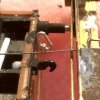VANWIDE
Lyndhurstman
Western Thunderer
Vans: der graft generator
A few hours doing tiny trains this Saturday afternoon. The Parkside Dundas sextet have had their coupling hooks fitted (courtesy of Dave Franks at LMS) and rooves courtesy of the bits box. As noted in an earlier post, I was going to make my own packing boxes for the couplings, but wobbling back and forth through the LMS website, I noted that their versions come in packs of 12. It sounded to synchronous to slide past....

They're coming on. Progress is glacial. The mojo is definitely on the down low. Still buffers and couplings, and painting and lettering.
Cheers
Jan
A few hours doing tiny trains this Saturday afternoon. The Parkside Dundas sextet have had their coupling hooks fitted (courtesy of Dave Franks at LMS) and rooves courtesy of the bits box. As noted in an earlier post, I was going to make my own packing boxes for the couplings, but wobbling back and forth through the LMS website, I noted that their versions come in packs of 12. It sounded to synchronous to slide past....

They're coming on. Progress is glacial. The mojo is definitely on the down low. Still buffers and couplings, and painting and lettering.
Cheers
Jan


















 I think a distinct part of it (as with all of my efforts) is learning new things. And the AJ, with its bends and angles, and lack of visibility, is a good challenge. Especially now that
I think a distinct part of it (as with all of my efforts) is learning new things. And the AJ, with its bends and angles, and lack of visibility, is a good challenge. Especially now that 







